Eggplant is a tropical plant originating from eastern India, from where it spread throughout Asia, particularly in China, which is considered a secondary center of origin.
In Europe, it was first mentioned in the 14th century, initially in Spain, where it was brought by Arab traders, as well as to North Africa. It appeared in Italy in the 15th century and in Croatia in the 16th century.
Eggplant is available on the market from May to November and can be grown in open fields and protected spaces (greenhouses and tunnels), especially in the southern regions of Croatia. The chemical composition of the fruit varies depending on the variety and cultivation method. Sugars make up 30 – 35% of the dry matter, which is significantly lower than in other vegetable species, with glucose being the most prevalent. The fruits contain the most phosphorus, magnesium, and calcium among the mineral substances. In addition to vitamin C, they contain nicotinic acid, vitamin B, and small amounts of carotene. Furthermore, eggplant is low in calories. In the 17th century, due to ignorance, it was called the “apple of madness,” as consuming under-ripe or raw fruits, which contain solanine, caused digestive issues.
The Latin name for eggplant is (lat. Solanum melongena L.), and it belongs to the Solanaceae family.
Nutritional Value of Eggplant
Eggplant is a relatively underrepresented food in the diet, so it does not have significant economic importance.
Due to the presence of solanine, technologically ripe eggplants should not be consumed before cooking. Solanine is a toxic glycoalkaloid specific to plants in the Solanaceae family, serving to protect the plant from pests.
Compared to its relatives, peppers and tomatoes, eggplant has lower nutritional value, but when combined with other foods, it contributes to a balanced diet. Eggplant is primarily a dietary food, with 100 g of fresh fruit containing 24 kcal of energy.
| Table 1 – Nutritional Value of Fresh Eggplant | Nutrient Composition | Amount (%) |
|---|---|---|
| Crude Protein | 0.7 – 2.3 | |
| Crude Fat | 0.1 – 0.21 | |
| Carbohydrates | 2.2 – 5.6 | |
| Fiber | 0.8 – 0.9 | |
| Minerals | 1.1 | |
| Water | 91.0 – 93.4 |
| Table 2 – Mineral Composition of Eggplant | Mineral | Amount (mg/100 g fresh fruit) |
|---|---|---|
| Sodium | 2.5 – 10 | |
| Potassium | 214 – 294 | |
| Magnesium | 9.5 – 18 | |
| Calcium | 9 – 22 | |
| Phosphorus | 12 – 5 | |
| Iron | 0.39 – 0.5 | |
| Sulfur | 15 |
| Table 3 – Vitamin Content in Eggplant Fruit | Vitamin | Amount (mg/100 g fresh fruit) |
|---|---|---|
| Carotene | 0.018 – 0.03 | |
| B1 | 0.03 – 0.07 | |
| B2 | 0.04 – 0.06 | |
| B3 | 0.5 – 0.8 | |
| C | 3 – 19 |
Morphological Characteristics of Eggplant
Eggplant is an annual plant, ranging in height from 0.5 to 1 meter, depending on the variety, and occasionally growing taller.
The majority of the roots are located within the top 30 centimeters of the soil. The stem is herbaceous, woody at the base, and branches like a shrub. The leaves are large, oval, and more or less lobed, hairy, with a dark green upper surface with purple outlines, and a mostly purple underside with prominent veins (which may have spines). The flower is light purple and appears after 7 – 11 leaves, usually solitary, although some cultivars may produce 2 – 3 flowers per internode. Eggplants are predominantly self-pollinating, but about 20% of pollination is cross-pollination.
The fruit is a berry of varying size, shape, and color. The seeds are small, disk-shaped, and light brown. A single fruit can contain 150 – 400 seeds. Parthenocarpy (the development of fruit without fertilization and without seed formation) is also present.













































